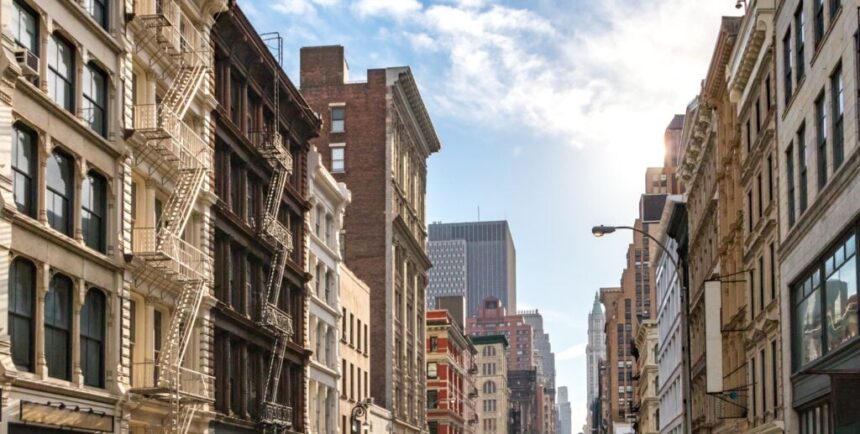New York State legislative leaders have agreed on a preliminary housing deal aimed at tackling affordability and supply problems, which are especially severe in New York City.
The legislation, which was intended to balance the interests of tenants and property owners/developers, has spurred discontent on both sides. A group of Democratic lawmakers indicated they would not support some of the provisions, which they believe weaken tenant protections, while Republican leaders and landlord advocacy groups are concerned the legislation would exacerbate New York’s housing crisis. The plan may require alterations to gain full legislative approval.
Here’s a detailed look at some of the proposed measures, the groups that oppose them, and potential outcomes should the plan take effect.
Providing for “Good Cause Eviction” Rules, with Exceptions
The proposed “good cause eviction” provision would limit the circumstances for legal evictions and discourage rent increases above a threshold. Landlords would still be able to evict tenants who violate their lease agreements, but they would not be able to evict tenants for nonpayment of rent after an “unreasonable” rent increase without explanation.
The plan would allow for rent increases up to the lesser of 10% or 5% plus the consumer price index in non-rent-stabilized apartments. Landlords who implement steeper rent increases without reason would not have just cause for eviction if a tenant failed to pay rent. In addition, landlords would be required to automatically renew leases unless they have just cause to evict.
The proposed rule is modeled after other “good cause” laws in other states, including neighboring New Jersey, but includes some important exceptions. The measure would not apply to landlords renting fewer than 10 units, buildings constructed within 30 years following the rule’s enactment, or units with monthly rents above a certain threshold. Municipalities outside New York City would also need to opt in for the rule to apply to its residents.
A group of about 50 lawmakers argue the legislation doesn’t provide adequate protection for tenants. A 2019 “good cause” bill that failed to pass would have been more expansive, with a lower cap on rent increases and fewer exclusions. On the other hand, property owner advocates contend that the burden on landlords would lead to higher asking rents for vacant units and disincentivize investment in rental housing, including maintenance and development.
Proponents note “good cause eviction” hasn’t curtailed new construction in New Jersey, but they admit it hasn’t prevented evictions either, in part because the law lacks a specific threshold above which a rent hike is deemed unreasonable.
Relaxing 2019 Tenant Protections That Burden Landlords
While the proposed legislation makes it tougher for landlords to raise rents and evict tenants, it also repeals earlier tenant protections in certain circumstances, benefiting landlords of rent-stabilized apartments. The current law only allows landlords to raise rents enough to recoup $15,000 in repairs over the course of 15 years. That amounts roughly to an $89 per month increase for an individual unit, and the law requires the increase to be removed after 30 years.
The new housing plan would raise the limit to at least $30,000, allowing landlords to increase monthly rents by as much as $167, with higher allowances for units recently vacated by long-term tenants. Landlords could recoup as much as $50,000 if the prior tenant lived in the unit for 25 years or longer. Rent increases made to recoup the cost of improvements would also be permanent.
Tenant rights activists oppose any changes to the 2019 law, which was intended to prevent landlords from unfairly removing tenants in order to charge higher rents. But the limitations may be contributing to the affordable housing shortage in New York City.
Though census data pins the NYC vacancy rate at 1.4%, a 50-year low, that figure doesn’t include thousands of vacant, rent-stabilized apartments that landlords are incapable of renting. The New York City Housing and Vacancy survey found that an estimated 26,310 rent-stabilized apartments sat empty last year, and some experts say the actual figures could be higher.
Because renters tend to hold on to rent-stabilized apartments in this notoriously expensive city and because landlords must get tenant approval to make repairs and updates during their tenancy, some rent-stabilized apartments haven’t been updated in 20 to 50 years. When tenants finally move out, the units they leave behind may not be compliant with current housing codes. This means that in order to legally rent the unit again, landlords need to complete expensive repairs.
The required renovations often cost more than $75,000, an expense that would take 75 years to recoup under current limits on rent hikes. And since operating costs for many rent-regulated units exceed allowable rents to begin with, there’s little incentive for landlords to make the necessary updates. Real estate lobbying groups contend revisions to the 2019 law aren’t sufficient to bring those vacant units back online.
Incentivizing New Construction and Redevelopment
According to Washington-based nonprofit Up for Growth, the New York City metro needs an estimated 340,000 homes to meet housing demand. But, apartment building permit applications have declined since a tax abatement program expired in 2022. Apartment buildings are taxed at a steeper rate than condos or single-family homes, and many developers say they’re not economically feasible to build, especially amid construction labor shortages and inflated building costs.
The new housing deal includes the “485x” tax break, which would apply more extensively than the 421-a program it aims to replace, though lawmakers are still ironing out the details. Many developers relied on the 421-a program, but critics say it wasted tax revenue, so lawmakers will likely try to address that issue.
Depending on the specifics, however, the new tax benefit may not be effective. One labor union is requesting that lawmakers include a $40 minimum wage requirement for all union and nonunion construction workers supporting projects that benefit from the 485x tax break.
It’s also not clear yet how many affordable units developers will need to include in a project to be eligible for the incentive. If developers find the wage increase isn’t offset by the revenue potential of a project due to affordability constraints, the 485x tax break may not seem that attractive.
Some officials think a tax break won’t fix the city’s broken property tax system, which taxes some working-class homeowners at higher rates than luxury brownstone owners. A major reform could address that issue while also reducing the tax rate on rental buildings, which the New York City Comptroller notes is about twice the rate collected on condos and co-ops.
This provision in the new housing legislation hasn’t brought the same backlash as other aspects of the plan, though some Democratic lawmakers criticized a previously proposed incentive as catering to corporations, and the Real Estate Board of New York said the measure would be insufficient to increase NYC’s housing stock, especially alongside other challenges the legislation introduced for real estate investors.
The deal would also loosen residential density restrictions. That measure, if implemented alongside Mandatory Inclusionary Zoning, could lead to the construction of 30,000 affordable housing units, according to an independent nonprofit organization. Another tax break included in the plan would encourage office-to-multifamily conversion projects, which would make room for an additional 20,000 units, according to estimates.
The Bottom Line
Just about every group is angry about some aspect of New York’s housing proposal, which state legislative leaders worked on for 15 months before reaching a compromise. Lawmakers have already begun voting on the New York state budget for fiscal year 2025, but the final details of the housing deal have not yet been announced.
Due to many unknowns, it’s unclear whether the agreement will make a dent in New York City’s housing crisis. While some provisions of the deal could ease the pressure on New York landlords, the “good cause eviction” policy will likely lead some real estate investors to seek opportunities elsewhere.
Ready to succeed in real estate investing? Create a free BiggerPockets account to learn about investment strategies; ask questions and get answers from our community of +2 million members; connect with investor-friendly agents; and so much more.
Note By BiggerPockets: These are opinions written by the author and do not necessarily represent the opinions of BiggerPockets.









